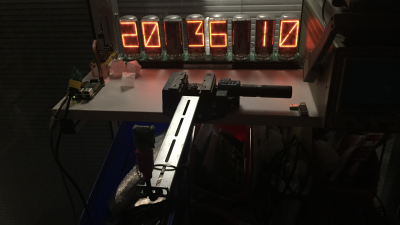[Robin Bussell]’s NixieBot is a mash up of new age electronics and retro vintage components and he’s got a bunch of hacks crammed in there. It’s a Nixie tube clock which displays tweets, takes pictures of the display when it encounters tweets with a #NixieBotShowMe hash tag, and then posts requested pictures back to twitter. If a word is eight characters, it takes a snapshot. If it’s a longer message, NixieBot takes a series of pictures of each word, converts it to an animated GIF, and then posts the tweet. In between, it displays random tweets every twenty seconds. You can see the camera setup in the image below and you should check out the @nixiebot twitter feed to see some of the action.
 For the display, he’s using eight big vintage Burroughs B7971 Nixie Tubes. These aren’t easy to source, and current prices hover around $100 each if you can find them. The 170V DC needed to run each tube comes from a set of six 12V to 170V converter boards specifically designed to drive these tubes. Each board can drive at least a couple of nixies, so [Robin]’s able to use just four boards for the eight tubes. Each nixie is driven by its own “B7971 SmartSocket“, a dedicated PIC16F690 micro-controller board custom designed for the purpose. A serial protocol makes it easy to daisy-chain the SmartSockets to build multi character displays.
For the display, he’s using eight big vintage Burroughs B7971 Nixie Tubes. These aren’t easy to source, and current prices hover around $100 each if you can find them. The 170V DC needed to run each tube comes from a set of six 12V to 170V converter boards specifically designed to drive these tubes. Each board can drive at least a couple of nixies, so [Robin]’s able to use just four boards for the eight tubes. Each nixie is driven by its own “B7971 SmartSocket“, a dedicated PIC16F690 micro-controller board custom designed for the purpose. A serial protocol makes it easy to daisy-chain the SmartSockets to build multi character displays.













